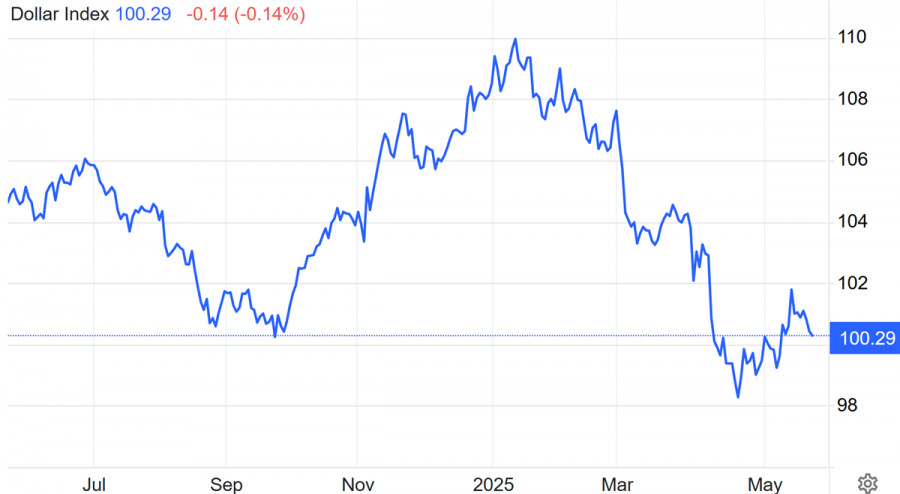Historically, the U.S. dollar has been the primary safe haven during crises such as wars, sanctions, and banking shocks; investors tend to flock to the dollar as their ultimate safety net.
In 2025, the situation has changed dramatically. Donald Trump is returning to the White House with protectionist initiatives, promising to impose import tariffs. Meanwhile, the dollar is declining. Since the start of the year, the U.S. Dollar Index (DXY) has dropped nearly 6% against a basket of major currencies. This isn't just a dip — it's a fundamental shift.
For traders, this is a signal: the market has begun to reprice the dollar as a safe-haven asset and the notion of America as the backbone of the global financial system. This is no longer just about charts—geopolitics, trust, and ideology are now in play.
The Hegemon Under Pressure
The dollar still serves as the backbone of the global financial system. It dominates transactions, central bank reserves, and capital markets. Even sanctions are essentially tools of "dollar hegemony." But dominance requires more than just economic might — it demands stability, rule of law, and predictability.
And now? The Fed's independence is in question. Legislation is becoming increasingly populist. Foreign policy is reactive and erratic. In this atmosphere, investors are starting to wonder: Will the dollar continue to serve as the anchor of global liquidity?
Add to this the largest U.S. national debt since World War II, and you have a cocktail not every risk manager wants to sip without a stop-loss.
The Fed, Recession Risks, and Betting on Weakness
While some brace for another tariff war, others examine the U.S. economy under a microscope. Recession risks are rising, and markets have already priced that in.
Expectations for Fed rate cuts have gone mainstream, and that's a direct threat to the dollar. Yields are falling, and capital is fleeing.
Traders are now betting on a multi-currency scenario. The euro, yen, and even the yuan are gaining ground as potential recipients of reallocated liquidity. Meanwhile, gold is back in vogue, reminiscent of the 1970s: April saw a record high, up 20% since the start of the year.
Mixed Signals from the Administration
Washington is sending conflicting signals. The Treasury Secretary defends the strong-dollar policy. Meanwhile, the Commerce Secretary promotes the benefits of a weaker currency.
The White House, for its part, muses about the "burden of reserve currency status" — a phrase that sounds suspiciously like fatigue with leadership.
If a weaker dollar is not an accident but a strategic choice, we may be on the verge of a new global trading model—one in which the dollar is no longer king but first among equals.
What a Weaker Dollar Means for Markets
For U.S. exporters, it's a gift. From Boeing to Apple, margins improve when revenues are in euros and expenses in dollars. But it's no joke for American consumers: import prices rise, inflationary pressures grow.
Financial markets are also entering turbulent waters. A weaker dollar could mean higher interest rates, as investors demand a premium for risk. That implies higher borrowing costs, more expensive debt servicing, and potentially a new wave of fiscal discipline.
Who Will Challenge the Dollar?
History has seen attempts to dethrone the dollar: the yen in the 1990s, the euro in the 2000s, and, in theory, the digital yuan. But the U.S. always pulled through thanks to its economic heft. Today, the U.S. economy is still larger than that of China, Germany, and Japan combined.
Still, the world is adapting to currency pluralism. Capital flows into the euro, yen, gold, and government bonds of countries with predictable macro strategies. The question is no longer whether the dollar will fall, but what role it will return to.
For Traders: What's Next?
The current dollar correction isn't just a bounce — it's a movement with deep fundamental roots. Even with a possible short-term rebound in May, the long-term structure remains vulnerable.
Conclusion: The period of unquestioned dollar dominance has begun to weaken. That means a multi-currency portfolio isn't a luxury — it's survival. Diversification is no longer a trend; it's a requirement in a world where politics and geopolitics influence markets as much as macro and technical analysis.
Current Technical Picture for the Dollar
The Dollar Index (DXY) is approaching the key psychological level 100.00. Investors are watching the fallout from Moody's U.S. credit rating downgrade — not the rating itself, but the language used, which damaged confidence.
A Deutsche Bank survey fueled the fire: 80% of participants say the U.S. debt trajectory is unsustainable, and 26% see a return to QE as a likely response to the next crisis.
Only 20% of respondents believe markets can absorb a 9% deficit-to-GDP ratio by 2035.
Geopolitical tension is only adding fuel to the fire. Europe and Canada are discussing sanctions against Israel, the Gaza situation is deteriorating, and the U.S. has made a surprise withdrawal from the Ukrainian front. Trump's statement that "this is not our war," following a call with Putin, drew condemnation from the EU and weakened the dollar's status as a global safe haven.
To investors, America no longer guarantees global order, and the dollar is no longer the undisputed shelter in the storm.
Stock traders are looking for more guidance from the Fed, with significant comments anticipated on Tuesday following a series of hawkish statements on Monday. However, even if these statements are aggressive, they are unlikely to bolster the dollar if confidence in U.S. fiscal stability continues to decline.
The technical situation is becoming increasingly tense. The support level near 100.22 is close to breaking down. If this zone fails, we could see a drop to test the 2024 lows of 97.91 and 97.73. Below these levels are further support zones at 96.94, followed by 95.25 and 94.56, which may indicate a return to levels not seen since late 2022.
In the event of a rebound attempt, resistance forms around 101.90-101.94, which is where the 55-day SMA and levels that previously served as the foundation for the H&S reversal pattern are located.
A sustained consolidation above this range is needed for a potential move to 103.18, a key level of medium-term resistance.
However, market conditions are favoring sellers at this moment. The dollar no longer appears as it has over the past two decades.













